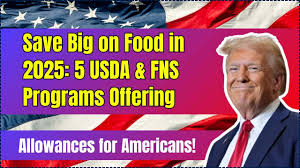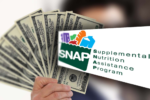Food costs are a significant part of every household’s budget. As prices continue to rise, finding ways to save while still maintaining a nutritious diet has become a priority for many American families. Fortunately, the U.S. Department of Agriculture (USDA) and its Food and Nutrition Service (FNS) are stepping in with a range of programs designed to ease the burden. Let’s explore these initiatives, their benefits, and how you can take advantage of them.
Top 5 USDA & FNS Programs for 2025
1. Supplemental Nutrition Assistance Program (SNAP)
SNAP, formerly called food stamps, remains the largest and most impactful food assistance program in the U.S. It offers monthly benefits via an EBT card, enabling families to purchase essential groceries from stores, farmers’ markets, and online.
Key Features:
- Eligibility: Based on household income and size.
- Benefit Example: A family of four earning less than $3,677 monthly can qualify for up to $975 in benefits.
- Pro Tip: Look for programs like Double Up Food Bucks in your state to maximize SNAP benefits at farmers’ markets.
2. Special Supplemental Nutrition Program for Women, Infants, and Children (WIC)
WIC supports low-income women, infants, and children under five by providing access to nutritious foods, health referrals, and breastfeeding assistance.
Key Features:
- Covers essentials like baby formula, milk, fruits, and whole grains.
- Offers free nutrition education tailored to child development.
- Pro Tip: States now use digital WIC cards for convenience in shopping.
3. The Emergency Food Assistance Program (TEFAP)
TEFAP delivers USDA food to community food banks and pantries, ensuring families in sudden financial hardship can access groceries.
Key Features:
- Distributed through local organizations like food banks.
- Includes fresh produce, canned goods, and proteins.
- Pro Tip: Check with your local food bank to learn about TEFAP availability.
4. Child and Adult Care Food Program (CACFP)
CACFP helps child care centers, after-school programs, and adult care facilities by reimbursing meal and snack costs.
Key Features:
- Targets care providers to ensure balanced diets for participants.
- Parents can ask their child’s care facility if they participate in CACFP.
5. National School Lunch Program (NSLP)
This program provides free or reduced-price meals to schoolchildren, ensuring they receive nutritious food while meeting USDA guidelines.
Key Features:
- Income thresholds determine eligibility; most families earning under $39,000 qualify.
- Meals include breakfast and lunch options at participating schools.
Why Food Assistance Is More Important Than Ever
In 2024, the Consumer Price Index for food at home rose by 4.9%. The trend is expected to continue, making programs like SNAP and WIC essential for families. These initiatives not only help households afford food but also promote healthier eating habits, ultimately reducing long-term medical costs.
How to Apply for Food Assistance
Step-by-Step Guide:
- Check Eligibility: Visit Benefits.gov to find programs suited to your income and household size.
- Gather Documents: Prepare proof of income, household size, and identification.
- Apply Online or In-Person:
- SNAP applications are available on state-specific portals.
- WIC and TEFAP benefits can be accessed through local agencies.
- Follow Up: Monitor your application and complete any additional steps.
Additional Resources for Saving on Groceries
Local Food Banks
Nonprofits like Feeding America work with USDA programs to distribute free groceries. Use their website to locate a nearby food bank.
Community-Supported Agriculture (CSA)
CSAs offer affordable, locally-grown produce. Many accept SNAP benefits or offer discounts for low-income families.
Meal Planning Apps
Apps like BudgetBytes and Mealime can help you create cost-effective, nutritious meal plans, reducing food waste and saving money.
FAQs: Addressing Common Concerns
- Can I use multiple programs simultaneously?
Yes! Many households combine WIC for children and SNAP for broader needs. - Do food assistance benefits expire?
SNAP benefits roll over for a few months but will expire if unused. - Are benefits taxable?
No, food assistance benefits are not taxable income. - What if I don’t qualify for these programs?
Explore local nonprofits, community food banks, and church initiatives for support.
With rising food costs, the USDA’s 2025 programs are crucial in ensuring every family has access to affordable and nutritious food. Don’t miss out on these life-changing benefits—explore these programs today to start saving on your grocery bills while building healthier eating habits.








